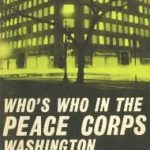Making Lemonade In The Maiatico Building (Repost)
There is a lot one can write about those early days of the agency when the Peace Corps attracted the best and the brightest. An early document of the agency said that the staff in D.C. and around the world was composed of “skiers, mountain climbers, big-game hunters, prizefighters, football players, polo players and enough Ph.D.’s [30] to staff a liberal arts college.” There were 18 attorneys, of whom only four continue to work strictly as attorneys in the General Counsel’s office and the rest [including Sargent Shriver] did other jobs. Also, all of these employees were parents of some 272 children.
In terms of staff and PCVs, the ratio was quite small. Figures from WWII show that 30
people were required to support every soldier in the front lines. After the war, the peacetime ratio was one person in Washington to every four overseas.
The Peace Corps was organized with the goal of ten Volunteers on the job for every administrative or clerical person in support, and that meant everyone, from clerks, typists [remember them?] to overseas staff.
In those heavy early days when HQ was located in the Maiatico Building the agency worked on Saturdays, Sundays, and late into the evening. There is a famous photo that appeared in a Washington newspaper of the building all ablaze with lights as the staff worked far past closing time in those early months of ’61.
worked on Saturdays, Sundays, and late into the evening. There is a famous photo that appeared in a Washington newspaper of the building all ablaze with lights as the staff worked far past closing time in those early months of ’61.
It was that kind of spirit that made the Peace Corps very special. Or as Kennedy said to the Peace Corps staff early in 1961, “I do not think it is altogether fair to say that I handed Sarge a lemon from which he made lemonade, but I do think that he was handed and you [The Peace Corps staff] were handed one of the most sensitive and difficult assignments which any administrative group in Washington has been given almost in this century.”
In his recommendations to Kennedy about how to set up the agency, Shriver had listed people he thought should be the Director. Included in this list where Eugene Rostow of Yale, Carroll Wilson of MIT, Gilbert White of the University of Chicago, and Clark Kerr of UCLA. All of these men had had experience with small overseas service programs involving the training or replacement of American students in the Third World. Kennedy rejected all of them.
Gerard T. Rice in his book The Bold Experiment said Kennedy wanted “the Peace Corps to be an adventurous foreign policy initiative and he did not feel that a bookish type of leader would be consonant with that ethos.”
The Peace Corps in these heavy days was being covered closely by the press, especially by David Halberstam and Peter Braestrup of the New York Times.[One rumor that I heard often in those early days was that Halberstam was taken with Nancy Gore, Al’s sister and that kept him close to the Peace Corps offices, at first only three rooms on the sixth floor of the Maiatico Building.] The Peace Corps was very much the symbol of Kennedy’s New Frontier in those first months of his administration. On February 1, 1961, the Gallup Poll said that the ‘idea of a Peace Corps’ had an approval rate of 71%, and that was across all age groups.
On March 5, Peter Braestrup reported on Shriver’s formal nomination at Peace Corps director and also the appointment of fourteen new staff members. According to Coates Redmon people were showing up and going to work and did not know if they were being paid. Shriver came to work as a dollar-a-year-man and early on he went to the personnel director, Dorothy Jacobsen, to asked how he should go about getting government health insurance. “You can’t, Sarge,” she replied, “You don’t make enough money.”
Kennedy would sign the Peace Corps Act on September 22, 1961, in the White House. And at some point, JFK turned to Sarge and said his famous line about the creation of the Peace Corps, about how he had given Sarge a lemon and Shriver had turned it into lemonade.
Kennedy was right, and the Mad Men and Women drank the lemonade, and everything else, they could get their hands on.
No comments yet.
Add your comment